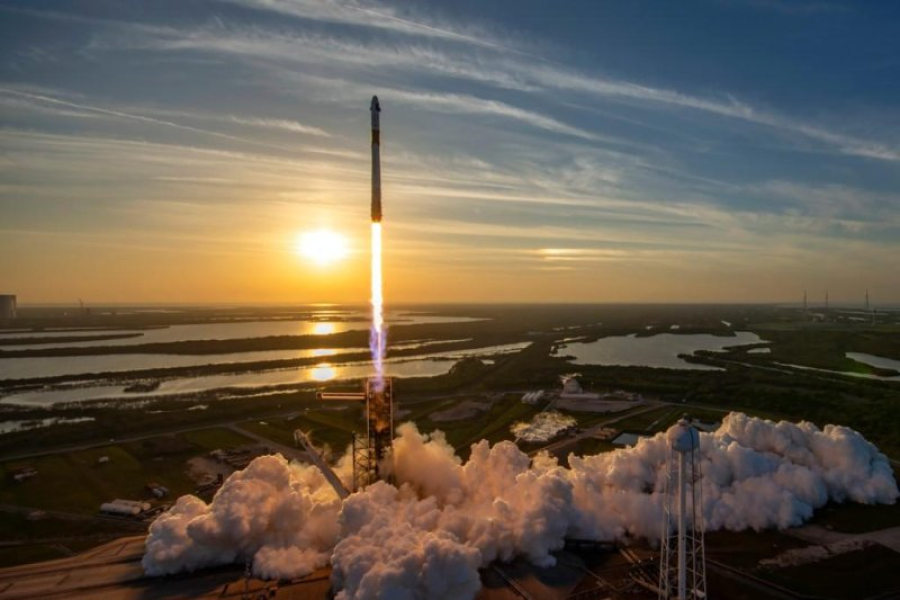
SpaceX successfully launched a new constellation of Starlink satellites into orbit Saturday morning, just 12 hours after the private company partnered with NASA to send four astronauts to the International Space Station — also from Florida.
Also on Friday evening, SpaceX launched 74 satellites from Vandenberg Space Military Base in California as part of a joint mission called Transporter 13.
All three launches used a Falcon 9 rocket.
SpaceX's launch of 23 satellites, including 13 with direct cellular connectivity, took place at 7:35 a.m. ET from the space station's Pad 40 at Cape Canaveral. Eight minutes later, the Falcon 9's upper stage landed aboard the unmanned Just Read the Instructions spacecraft in the Atlantic Ocean, completing its 18th mission.
It was SpaceX's 23rd launch from Florida this year.
The launch occurred two days, eight hours, 59 minutes and 40 seconds after the liftoff of Starlink mission 12-21, beating SpaceX's previous launch record at the site by nearly six hours.
Earlier in the day, at 11:43 p.m. PT, SpaceX launched satellites developed by Cape Canaveral-based Sidus Space.
“This flight carried 74 payloads, including CubeSats, microsatellites, hosted payloads, a return capsule, and an orbital transfer vehicle, of which 11 will be deployed later,” SpaceX said.
Transporter's first mission, launched in January 2021, sent a record 143 payloads into orbit, a feat that remains unmatched to date.
The rocket's first stage returned to Earth 7.5 minutes later, landing vertically with the help of its engine at Vandenberg. It was the 13th landing for the booster and the 400th for a Falcon 9 first stage overall, according to SpaceX.
Crew 10 will dock with the ISS on Saturday morning. The Dragon capsule is expected to arrive at the space station around 11:30 p.m. ET.
The crew includes commander Anne McClain and pilot Nicole Ayers of NASA, as well as mission specialists Takuya Onishi of the Japan Aerospace Exploration Agency and Kirill Peskov, a Roscosmos cosmonaut from Russia.
The Falcon 9 lifted off from Kennedy Space Center's Pad 39A at 7:03 p.m. under clear skies and a setting sun. The flight was cleared after fixing an air pocket in the hydraulic system of the clamp arm that supports the Falcon 9 rocket. The liftoff was scheduled for Wednesday but was canceled Thursday due to adverse weather conditions along the route.
Minutes after liftoff, the Falcon 9's first stage landed at Landing Zone 1 at Cape Canaveral Air Force Station.
Dragon then entered low Earth orbit.
When the spacecraft docks, there will be 11 crew members on board.
Aboard the Crew-9 capsule, Williams and Wilmore will return to Earth “no earlier than Wednesday, March 19,” NASA said. They will be joined by NASA's Nick Hague and Roscosmos' Alexander Gorbunov, who arrived at the ISS on Sept. 29, 2024.
Suni Williams and Butch Wilmore launched to the space station on the troubled Boeing Starliner on June 5, 2024, for what was planned as a weeklong test flight. The Starliner's problems delayed the mission by nine months.
SpaceX's next launch is scheduled for Monday from the Cape Canaveral Space Station's Pad 40. The launch window for the new batch of Starlink satellites opens at 2:09 p.m.
SpaceX has become NASA's primary means of transport to the ISS since the end of the shuttle program. Russia still sends people to the space station using the Soyuz.
The Moon and Beyond
SpaceX is also involved in landing humans on the Moon, scheduled for mid-2027 using NASA's Artemis III rocket.
On March 6, a SpaceX Falcon 9 rocket launched the Intuitive Machines IM-2 Athena spacecraft from Kennedy Space Center. The spacecraft later landed successfully on the Moon.
And billionaire Elon Musk is aiming to go to Mars.
Musk confirmed Saturday that SpaceX's Starship will launch to Mars in late 2026. On board will be Optimus, Tesla's humanoid robot. If all goes according to plan, humans could be on the Red Planet by 2029, though he acknowledged 2031 is more likely.
Musk's quote on the SpaceX website reads: “I can't imagine anything more exciting than going into space and being among the stars.”
SpaceX is conducting
Sourse: www.upi.com





